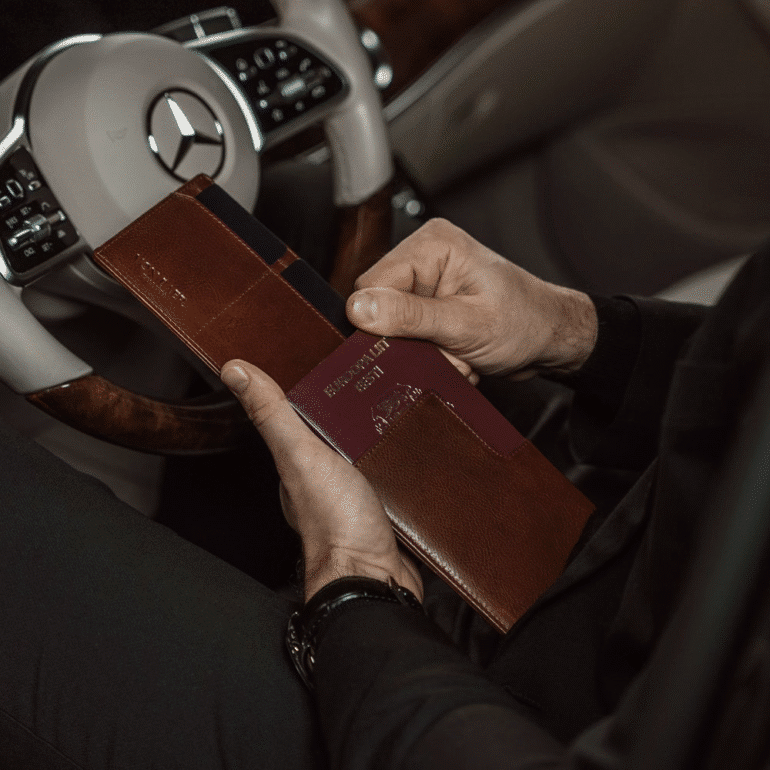Ever been that guy fumbling at airport security—boarding pass in one hand, coffee dripping down your sleeve, passport somewhere in the abyss of your bag? Of course you have. We all have.
But once you’ve lived the sharp rhythm of a well-made travel wallet, you realize: this is not about leather. It’s about control.
A wallet is not just a carrier of currency. It’s a field instrument of order—a quiet conductor of your personal symphony of movement. Every seam, every millimeter of spacing, determines whether you glide through a terminal like a Bond extra, or stall like a tourist digging for ID at Heathrow.
Picture it: a quiet click, the weight of full-grain leather in your palm, a card sliding out effortlessly just as your boarding zone is called. That moment feels like jazz—smooth, unhurried, precise. It happens because of design discipline. Every slot is intentional. Every hinge movement planned.
Look for a design that mirrors your rhythm. The business traveler shuttling between Zurich and Singapore needs different compartments than the weekend wanderer in Florence. Great design anticipates you like a trusted aide. Just as Churchill said, “Plans are of little importance, but planning is essential.”
And the numbers? They matter. A truly competent wallet carries: 8–12 cards, a passport, and two currency compartments—all within 25 mm of thickness when fully loaded. That balance between slimness and capacity defines ease.
Practical Expert Tip: Next time you travel, count how many unnecessary movements you make handling your current wallet. Each one is a leak in your efficiency. A great wallet seals those leaks so that travel becomes choreography.
Takeaway: Confidence while travelling stems not from luck, but from a layout engineered to pre-empt chaos before it begins.
Von Baer Harrington Wallet: Designed for Professionals
The Von Baer Harrington Wallet is a high-end passport wallet designed for professionals who value their appearance and preparedness.
Its full-grain Italian leather shell remains resilient across climates, while RFID shielding blocks the 13.56 MHz frequency digital thieves love. Inside, there’s no wasted space—each pocket placed for intuitive reach. The passport pocket’s recessed edge means no fumbling under dim terminal lights.
YKK Excella zipper (rated for 20,000 cycles) whispers rather than clicks. The gusseted sleeve expands 1.5 cm. Stitch density sits at eight per inch. The RFID layer is heat-bonded at 160°C for a lifetime hold. At 180–210 grams, it feels substantial but never bulky.
Practical Expert Tip: Alternate the direction of your currencies—one set facing up, another down. It halves transaction time and prevents bill confusion under pressure.
Choosing the Best Leather Material for Long-Term Travel Use
There’s a reason seasoned travelers stroke their wallets like they’re checking the hull of an old ship—material integrity tells its own story.
Synthetic fibers crack under pressure, but full-grain leather? That’s Hemingway’s typewriter: stubborn, reliable, and a little more charming with each mile.
Leather is not about luxury. It’s about endurance.
High-altitude cabins dry the air to 8% humidity. Tropical tarmacs hit 35°C or higher. Low-grade leather behaves like cardboard. Vegetable-tanned hides adapt like skin—flexing, breathing, responding.
Apply 2 ml of neatsfoot oil twice a year, and you’re not just preserving a wallet—you’re keeping a companion alive.
Feel the grain. If it’s too smooth, someone sanded away the story. Aniline or semi-aniline finishes (0.3–0.5 mm coating) allow a natural patina to develop. The best full-grain leather measures 15–25 N/mm² in tensile strength and survives 10,000 flex cycles without cracking.
Practical Expert Tip: Press your thumb against the leather. If it darkens with warmth and releases scent—earth, oil, smoke—you’ve got a genuine hide. If it feels like vinyl, walk away.
Takeaway: Fine leather doesn’t wear out—it writes its autobiography across the years.
Understanding Travel Wallet Design and Layout for Efficiency
Too many brands confuse minimalism with good design. A sleek exterior with nowhere to put your boarding pass? That’s not minimalism—it’s sabotage.
The masters of function (like Dieter Rams or Moleskine’s original designers) knew: structure equals calm.
A wallet should work like a blueprint of your movements. Four zones keep everything frictionless:
- Front Access Zone: cards you reach for ten times a day
- Secure Zone: passport, ID, insurance
- Transit Zone: boarding passes, customs forms
- Overflow Zone: currencies, coins, receipts
Each slot, each fold should obey the one-hand rule. Picture standing at Charles de Gaulle, coffee in one hand, ticket gate in front—can you get what you need without a shuffle?
Card slots spaced 3–4 mm apart reduce friction. Passport sleeve (125×90 mm) prevents corner bending. RFID lining covering 80% of interior keeps data invisible to scanners.
Practical Expert Tip: Take a printed boarding pass (8×3 inches). If you need to fold it to fit your wallet, that’s a red flag. Proper design respects real-world dimensions.
Takeaway: A wallet’s beauty lies not in its face, but in its choreography.
How to Identify Durable Construction in a Travel Wallet
Forget the glossy brochure. True craftsmanship hides in micro-engineering.
Run your fingernail along the edge—waxy smoothness? That’s beeswax edge burnishing at 70°C. Check the stitching: saddle-stitching (two needles crossing) won’t unravel under tension.
Hardware tells its own story. Brass snaps (CuZn37 alloy) withstand 95% humidity. RiRi or YKK Excella zippers glide through 10,000+ cycles without complaint.
If a brand offers refurbishment services, that’s your signal—they believe in longevity. Those that don’t, won’t.
Practical Expert Tip: Hold your wallet horizontally. If it slumps inward, its reinforcement layer is cardboard, not leatherboard. You deserve better than something that collapses before your next connection.
Takeaway: Quality whispers. You feel it in the edges, hear it in the silence of a zipper that never snags.
Organizing Your Travel Wallet to Reduce Stress
Ever lost a boarding pass seconds before boarding? Your pulse races, logic vanishes. The problem isn’t you—it’s your system.
Cognitive load theory tells us that every decision drains mental energy. A disorganized wallet steals that energy silently.
Organize it like a cockpit: Top layer—credit cards. Middle—passport, insurance, boarding pass. Rear—currency. Zip section—coins, SIM cards, keys.
Consistency breeds muscle memory. After a few trips, your hands move before thought.
8–10 card slots strike the perfect balance. Over 12? You create bulge and friction. Keep wallet depth below 20 mm for pocket-friendliness.
Practical Expert Tip: Run a “lost wallet drill.” Know your emergency protocol—backup cards, digital copies of IDs, secure cloud folders. Preparedness may sound obsessive until it saves you in Delhi traffic.
Takeaway: Calm begins where clutter ends. Simplicity is not minimalist—it’s survival psychology.
Travel Wallet Security and Accessibility Tips
Security and speed are often opposites—unless your wallet bridges the two.
A good travel wallet behaves like a fortress with a secret passage: impenetrable to others, effortless for you.
RFID shielding blocks digital theft. Hidden zippers and magnetic closures keep contents secure. Smooth exteriors deny grip to pickpockets.
Inside, build tiered access: one layer for essentials, one for reserves. Keep daily cash separate from your stash. That way, when paying for a cab in Rome, you don’t reveal your whole bankroll.
Practical Expert Tip: Run your wallet through a metal detector. If your cards remain undetected, the RFID shielding is sound. Then tug every seam—if glue tears, abandon ship.
Takeaway: True security never interrupts flow—it travels with you, unseen but always engaged.
Finding the Perfect Travel Wallet Size and Shape
Let’s talk proportions.
Too bulky? Ruins the line of your jacket. Too small? Your documents look like origami gone wrong.
The golden mean:
- Size: ~190×110 mm
- Weight: 180–210 g
- Balance: ±10 g variance across the body
Even zip-around versions (210×120 mm) must pass the 2 kg lateral compression test and 30° spine flex without distortion.
Practical Expert Tip: Pack your typical travel load and test the fit. Sit, stand, walk. If it maintains shape, that’s good design. If it bulges like a baguette, move on.
Takeaway: Comfort and class share a postcode—somewhere between Milan tailoring and mathematical balance.
How Craftsmanship Creates Emotional Connection
A wallet becomes autobiography. Each nick, each darkened edge marks a border crossed, a deal signed, a drink paid for in an unfamiliar bar.
That’s why handmade wallets outlast trends—they hold memory like a journal pressed in leather.
Real artisans leave invisible fingerprints: thread tension, edge bevel curves, the faint scent of tanned oak bark.
Maintenance is the ritual that keeps the bond alive. Dust with a soft brush, condition with 1 ml pH-neutral cream, and let it rest overnight. Done twice a year, this extends wallet life from 15 to 25 years.
Practical Expert Tip: Create a pre-flight ritual. Wipe the surface, check each document, zip the passport sleeve. It’s not superstition—it’s control disguised as calm.
Takeaway: Craftsmanship turns leather into legacy—a silent witness to your miles.
Making Smart Choices to Improve Future Travel Experiences
A wallet is not a purchase—it’s a partnership.
The right one outlasts shoes, watches, even luggage. It shapes how you move, spend, and stay composed when plans change at 38,000 feet.
Ask yourself: Will this wallet still perform after 100,000 open/close cycles or 10 years of motion? If yes, you’ve found more than gear. You’ve bought time.
Keep a log: humidity, handling, load. You’ll find patterns and refine preferences. That’s how real travelers evolve—from casual consumers to connoisseurs of detail.
Practical Expert Tip: Think of your next wallet as your co-pilot. Does it keep pace when you’re jet-lagged, late, or lost? If yes, it’s the right ally.
Takeaway: A wallet isn’t just an accessory—it’s your passport to smoother journeys, one gate at a time.
What say you?
Thoughts on the XBest Travel Wallets for Men?
Let’s hear it!








